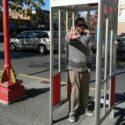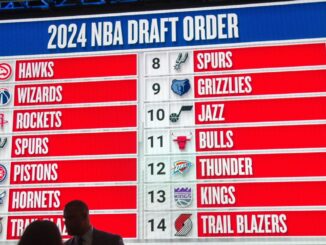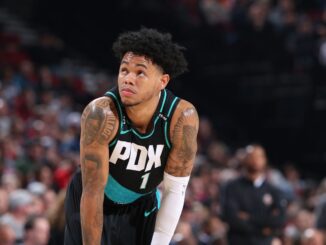
In addition to the NBA and the NBA G-League (officially known as the NBA Gatorade League), there are currently 10 professional basketball leagues operating in the United States, and these leagues are established, run, and scheduled without NBA influence. But the main takeaway is this: None of these leagues actually compete for your attention or mine. They exist, but few fans know about them, and even if they did, the likelihood they would watch any of these watered down “minor” leagues is in question.
With the XFL launching just the fourth major league to attempt to compete with the NFL (and the first since 1986), it raises the question: Why isn’t there an equivalent league attempting to compete with the NBA, and what challenges would that league face if they could drum up enough owner, player, and fan interest?
In an attempt to settle the matter once and for all, Oregon Sports News senior writers Bryant Knox (BK) and Casey Mabbott (CM) offer their unsolicited thoughts.
1. Aside from the ABA’s existence from 1967-1976, there has not been a challenger for the NBA or the fans of professional basketball. Not since, but ever. The XFL launched this year to compete for the attention of football fans, why do you think there is not an NBA equivalent?
BK: The timing here is interesting with the NBA’s ratings largely down. If there were ever a time to pounce and give it a shot, even if shooting modestly for short-lived or future interest, now might be that time. But the biggest reason there’s not a direct competitor like the XFL, I believe, has more to do with star talent acquisition than ratings (although one very clearly has an impact on the other). The XFL knows it’s going to play second banana to the NFL, or even third or fourth depending on how you feel about leagues such as the CFL and Arena Football. But the XBA (™ pending) knows it would be 11th banana in the U.S. market, and more importantly, a new basketball league would also have to compete with groups overseas that pay good money and idolize stars both young and old. Getting the up-and-comer who couldn’t make the NBA, or maybe the vet looking to revive his career, wouldn’t be an easy task. Even if a league is confident it’s going to have a niche it can survive on—or the ability to provide for players in a spectacular way—it would still know what it was up against.
CM: Honestly? It’s probably a combination of a lack of uber-wealthy interested parties and a series of gimmicks disguised as needed change in order to promote a new league. Do those two specific factors exist? Probably, but there isn’t anyone actively pursuing it as far as we know. What made the ABA successful early on in their existence (and an immediate threat to the NBA) was that they offered not only a more fan-friendly style of play (higher scoring, fewer restrictive rules, etc) as well as providing an option for players that needed to turn pro early due to hardship and had the talent to be in the NBA. Today, the NBA is a wide-open scoring machine and allows any player to enter the draft after they are one year removed from high school – regardless of their financial situation. Can a new league really promote itself via a 5-point line and lineups of high school players turned pro? Maybe, but there is reasonable doubt that that league succeeds and/or survives. A new league trying to avoid overspending to lure players would probably have to double down by allowing players the freedom to join the team of their choosing. Now some of you might be thinking “wait a minute, what stops the teams at the top from simply recruiting and signing the best players every year?” To which my response would be – why should we pretend the teams at the top got there only by drafting from their own assets anyway? Typically the teams at the top stay there because of their front office’s ability to continually negotiate deals that benefit them and make their roster talent sustainable. A new league would have to give their GMs even more ease of access to players, with creative incentives to join without overspending, otherwise you’re fighting the age-old battle of challenging the establishment via spending, and that’s a war that you can’t possibly win, not long-term anyway.
2. As sports fans we talk a big game about how available we would make ourselves to local teams in the right circumstances. Would a lower-priced ticket, fewer fans to fight for and easier/cheaper access to parking really draw you to a game with arguably less talent on the court?
BK: It absolutely would. Maybe I’m just a basketball junkie, but I remember going to Trail Blazers alumni games at local grade schools at probably eight years old, not a clue who any of the old dudes were sweating onto the Sexton Mountain hardwood floor, just because I loved the game and surrounded myself with hoops and hoopers every chance I could. Even today, if the 11th league very clearly had the 11th-ranked talent pool, I’d attend, if nothing else from time to time and just to be around the game I love. That said, I’d have a wish-list item I’d formally and passionately request ahead of the NBA’s newest competition—and I know you didn’t ask. But give me a WNBA team every day of the week if I have the option. That same basketball junkie who sought out past-their-prime dudes in goggles and short shorts also went to see the Portland Fire (WNBA) and Portland Power (American Basketball League) when his 7- and 8-year-old buddies were too embarrassed to admit those girls could hoop. That’s not a feminist humble brag 20-plus years in the making; it’s something between nostalgia and an appreciation for what women’s basketball has become, where it’s going and what it’s always been. I’m all for a new NBA-competitor league starting a team in Rip City, but I’d love the WNBA to make its return first.
CM: I certainly would be open to attending games more frequently if the ticket, concessions, and parking prices had a reasonable price structure, and I’m assuming the talent level won’t be there out of the gate and that’s fine. I have no idea who thought it was fair to charge the budget conscious fan $50 a seat and $10-20 a parking spot and $8 a beer, but that person is evil. That means you have to shell out $68 minimum to see the local team play – ONCE. And that is if you want to be hungry and thirsty most of the game. It only just gets crazier if you’re trying to bring a family along. I don’t care what the talent on the court is, if they are going to insist on charging those prices, like most reasonable fans I’ll have to treat a sporting event as a plan ahead budget-friendly outing and most of the time opt for the TV in my living room and my own beer, thank you.
3. Other than broadcasting games on local networks, what can newer leagues do to gain a following?
BK: Casey hit it on the head with the idea that something has to happen on an economic level. Hillsboro Hops games are legitimately fun experiences with quality baseball in a beautiful venue—and they also happen to be far more affordable (and less hectic) than other professional sporting events in the area. This has to be Step 1. Step 2 is finding a way to uniquely impact the minutiae of the game without compromising the integrity of the sport. Changing overtime to a straight-up game to 11, 1s and 2s playground-style, would be a fun and relatively minimal way of giving things your own flavor. Awarding automatic victories for windmills that knock opponents on their rear ends may render your league a relic after one season of cheap laughs. (Also, how did Shawn Kemp become commissioner of the XBA??)
CM: As I outlined in the question above, they will need to make the games more cost-friendly to the average fan, streaming games online would be a progressive option. How about partnering with Amazon Prime, streaming the local game live for a small fee, and if you buy the game they offer a game day discount on any team gear? Another thing to consider – the product on the court is not going to be comparable to the NBA out of the gate (if ever), and that’s fine. But given the top-heavy competition in the NBA, maybe it’s better if some of the good players that are not stars on the non-playoff teams go to another league and fight for a playoff spot in a league that’s a half a step behind the NBA and several steps in front of any developmental league.
4. What would the motivation be for players already in the NBA to move away from an established league and join a new league?
BK: For a player to actually move away from the NBA, it would have to be one of two scenarios in my mind, and they both involve getting back to the NBA: A) a young player isn’t getting the minutes he believes he’s earned. As a result, the NBA isn’t giving him the looks he thinks he deserves. If this new league is proving—or at least offering—a chance to hone your craft geared toward NBA-level performance, a prospect would be silly to consider jumping the pond. B) overseas destinations are also common for aging former stars. And some of those teams offer a lot of money, a chance to lead a roster and a ton of celebrity power in the process. But did you happen to catch what was missing in all of that? A path back to the Association. If this new league can act as a pipeline for the G-League or the league itself, no gimmick in the book would be as effective in drawing in talent as getting kids and vets alike where they ultimately want to be.
CM: Well the short version is they have to get something they aren’t getting today. Whether that’s a shot at a role they don’t feel they have today, or a larger contract, or maybe it’s playing for a team in a region they feel more at home, the new league has to give players the chance at a better career and a better quality of life. If you’re a player making big money on a team you like and you’re winning, you’re probably not going to cross the line. But if you’re not where you want to be or not winning or not making what you think you’re worth, why not give the new league a chance?
5. Aside from operating costs and inconsistent fan involvement, what challenges would a new league face in trying to take attention away from the NBA?
BK: Star player and fan interest. I know the question asked aside from inconsistent fan involvement, but I think those would really be the core issues, and that of the two, fan interest is the more boom-or-bust. Enthusiasm is fickle. If costs rise at the wrong time, the team never wins, the gimmicks prove too gimmicky, or even the general economy takes a dive, fans are gone and they’re not coming back. There are other sports to attend; there are approximately 37,011 streaming services to browse. Here’s the good news, though. While player interest could also be a problem, which I laid out earlier, it admittedly has a much higher floor than fan interest. Even if you never obtain the cream-of-the-crop hoopers to establish an elite product, there will always be basketball players and athletic guys who want to play basketball ready to compete. No sport—and I don’t even mean this in the worst way, although anyone who’s ever played at a park or an open gym can attest—there’s really no ego like a basketball ego. If you build it, they will come, and they will think they’re going to revolutionize Dr. James Naismith’s beautiful game by the time the clock strikes 0:00. That doesn’t always result in the best competition, but it ensures that as long as you’re willing to scrape, the hooper hopefuls will prove a bottomless barrel as long as your league is looking.
CM: If we’re ignoring money, the main obstacle would be giving expansion franchises to cities that don’t currently have a NBA pulse and hoping that team draws enough interest away from the NBA by giving fans a live experience rather than seeing it on TV. If the NBA doesn’t view the city in question as a viable expansion location, the new league would have to have reason to believe there is a fanbase there that just needs to be activated. The risk there is that even if there is local interest in professional basketball, the majority of that group may feel connected to any number of other franchises, and might not attend or watch games even if there is a local team. You’d be asking a casual unattached fan to commit and pay to see a team, without knowing if they’re any good. The other main challenge would be player interest – if you don’t think you can get at least one potential superstar (think what Dr J was to the ABA) to join forces and be the face of the new league, then you shouldn’t even bother. Something to consider is that the ABA was able to produce two superstars players who would win league MVP in their rookie seasons (Spencer Haywood, Julius Erving), and both would go on to have outstanding NBA careers. Will a new league be just as lucky? Perhaps, but perhaps not.
Final question and it’s an easy one. Yes or no – if a challenger to the NBA did arise, and we’re assuming their games were played at a different time than the NBA, would you watch?
BK: Yes.
CM: Yes.




